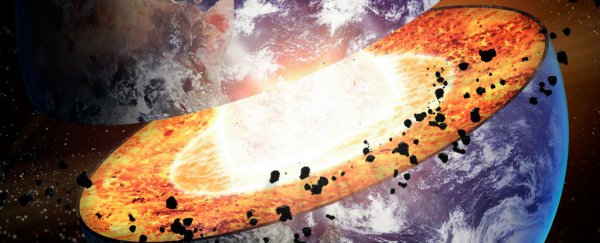If it sounds impossible to you that the surface of our planet is actually older than its inner core, prepare to have you mind blown, because according to new calculations, the inside of Earth is actually 2.5 years younger than the outside.
How is that even possible? Well, it all comes down to the effects of gravity on our planet, as predicted by Einstein's theory of general relativity.
Yep, that special little equation that follows us everywhere we go states that our position in a gravitational field (aka our space) regulates the rate at which time passes for us, and in the 4.5 billion years since Earth first formed, time has been moving more slowly in the core than on the surface.
It's something theoretical physicist Richard Feynman predicted back in the 1960s, reportedly stating in a series of lectures that the curvature of space-time should, in theory, put an age gap between Earth's centre and surface of a day or two.
Since then, this 'fact' has been cited in numerous papers by other physicists - and even university textbooks - but no one had bothered to investigate if Feynman's estimate was actually true.
Enter physicist Ulrik Uggerhøj from Aarhus University in Denmark, who himself admits to citing Feynman's famous speculation in previous papers before coming to the realisation that no study had gone to the effort of confirming the numbers.
"One should always be cautious and test even famous people's suggestions," he told Jacob Aron at New Scientist. "I fell into the trap of not doing it, I must admit."
So Uggerhøj recruited a team, and they got to calculating what's known as the gravitational potential of the surface and the core.
The gravitational potential of a particular object is calculated as the amount of 'work' - or energy transferred - per unit of mass that would be exerted by the force of gravity when that object is moved from one location to another in space. In other words, how much energy is needed to move a certain object from X to Y?
According to Einstein's general relativity, the more massive an object, the more the fabric of space-time is 'warped' by its existence, and this creates a gravitational pull that effectively slows time in the object's general vicinity.
An easy way to visualise this is to think about those giant, curvy grids that are often superimposed over illustrations of space to show how the fabric of the Universe is stretched out of shape by its most colossal residents - think black holes, or even our own planet.
This dictates that if you placed a clock at Earth's centre, it will tick ever-so-slightly slower than a clock at its surface, Emily Conover explains for Science News, because the core is considerably more massive than the surface, and therefore has a greater gravitational potential.
"Since climbing up from Earth's centre would be a struggle against gravity, clocks down deep would run slow relative to surface timepieces," says Conover.
We actually see this phenomenon in action in GPS satellites, which are situated about 20,200 km (12,550 miles) above Earth's surface. Because they're further away from Earth's gravitational field, their clocks tick faster than clocks on the surface, so the data they send back has to be corrected so everything is in sync.
Uggerhøj and his team figured out that since our planet came to be, time at the core has been lagging behind time at the surface by mere fractions of a second - around 0.0000000003 of a second - which seems negligible, but over the course of Earth's 4.5-billion-year lifespan, this has accumulated to a 1.5-year age difference.
When the differences in density of the core and the surface were factored in, this age difference was adjusted to 2.5 years.
Interestingly, Uggerhøj isn't ready to say that Feynman was wrong in saying that the core is younger than the surface by a day or two, because he might not have actually said that at all.
"Uggerhøj says it is unclear whether Feynman made the error originally, or whether the transcription of his lectures somehow garbled 'days' into 'years', but he says it pays to take nothing for granted," Aron reports for New Scientist.
Now, before you say anything, we still assume that Earth's core probably formed earlier than its surface, but because of the influence of gravity on time, its been ageing more slowly than its outwards-facing counterpart.
Uggerhøj acknowledges that we can't exactly test this experimentally, beyond calculating things according to the general relativity equation.
"But general relativity has passed every test thrown at it so far, so it seems likely to be correct," says Aron. "And since, as far as we know, the theory operates throughout the Universe, the same effect occurs for any massive body."
If you want an even more stark illustration of gravity's effect on time, take the Sun - the team calculates that the Sun's core is around 40,000 years younger than its surface.
Feynman. He truly is the gift to theoretical physics that just keeps on giving.
The study has been published in the European Journal of Physics.
